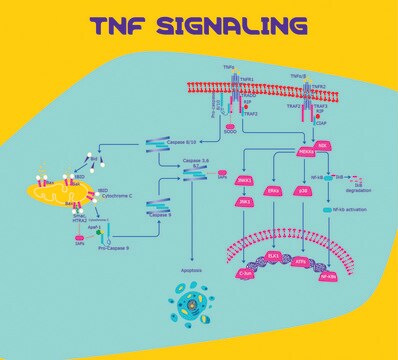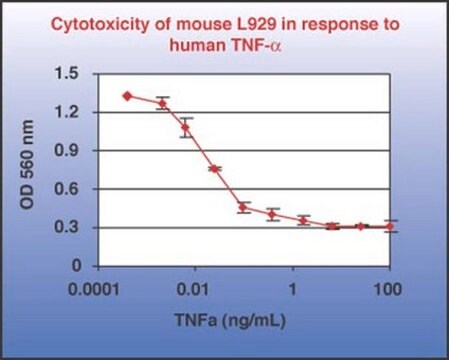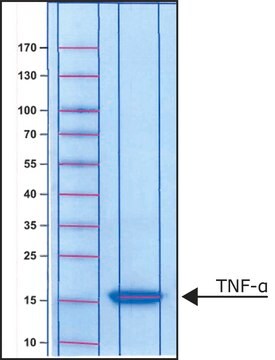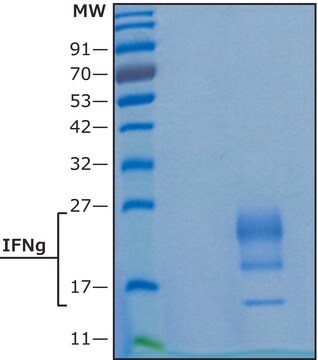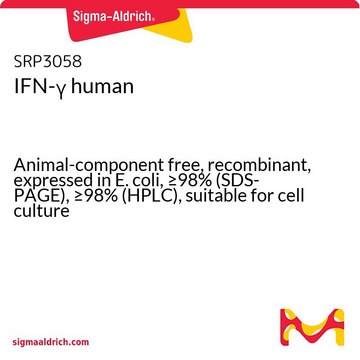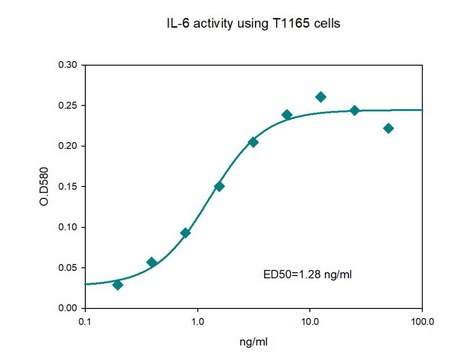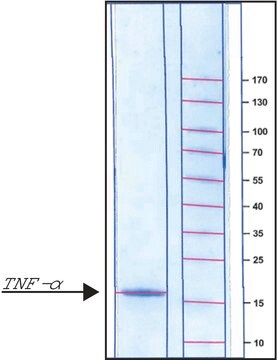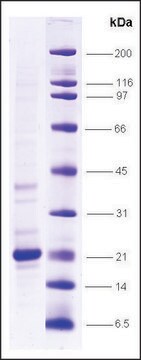H8916
Tumor Necrosis Factor-α human
≥95% (SDS-PAGE), recombinant, expressed in HEK 293 cells, lyophilized powder, suitable for cell culture
Sinonimo/i:
TNF-α
About This Item
Prodotti consigliati
Nome del prodotto
Tumor Necrosis Factor-α human, Xeno-free, recombinant, expressed in HEK 293 cells, suitable for cell culture
Origine biologica
human
Livello qualitativo
Ricombinante
expressed in HEK 293 cells
Saggio
≥95% (SDS-PAGE)
Stato
lyophilized powder
Potenza
≤1.0 ng/mL ED50
Qualità
endotoxin tested
PM
17 kDa (glycosylated)
~17.4 kDa
Confezionamento
pkg of 10 μg
Condizioni di stoccaggio
avoid repeated freeze/thaw cycles
tecniche
cell culture | mammalian: suitable
Impurezze
≤1.00 EU/μg (endotoxin)
N° accesso UniProt
Temperatura di conservazione
−20°C
Informazioni sul gene
human ... TNF(7124)
Cerchi prodotti simili? Visita Guida al confronto tra prodotti
Descrizione generale
Applicazioni
- In induction of netting neutrophils by anti-neutrophil cytoplasmic antibody and to study its effect on platelet activation and formation of monomeric C-reactive protein.
- To study the effect of TNF-α on miR-221 and fractalkine expression.
- To induce inflammatory cell responses.
- In NF-κB luciferase reporter assay.
- as a permeability inducing agent for endothelial cell monolayer permeability assay
- as a reactive oxygen species inducer in primary rat cardiac microvascular endothelial cells (RCMVECs)
- in the activation of nuclear factor kappa B (NF-κB) in human embryonic kidney cells (HEK293), neuroblastoma SH-SY5Y cells and HeLa cells
- in the stimulation of the human keratinocyte cell line(HaCaT) and human coronary artery endothelial cells (HCAECs)
Azioni biochim/fisiol
Nota sulla preparazione
Risultati analitici
Prodotto comparabile
Codice della classe di stoccaggio
11 - Combustible Solids
Classe di pericolosità dell'acqua (WGK)
WGK 2
Punto d’infiammabilità (°F)
Not applicable
Punto d’infiammabilità (°C)
Not applicable
Scegli una delle versioni più recenti:
Possiedi già questo prodotto?
I documenti relativi ai prodotti acquistati recentemente sono disponibili nell’Archivio dei documenti.
I clienti hanno visto anche
2 Replication of Classical Swine Fever Virus
Articoli
Lipid Induced Insulin Resistance
Il team dei nostri ricercatori vanta grande esperienza in tutte le aree della ricerca quali Life Science, scienza dei materiali, sintesi chimica, cromatografia, discipline analitiche, ecc..
Contatta l'Assistenza Tecnica.
